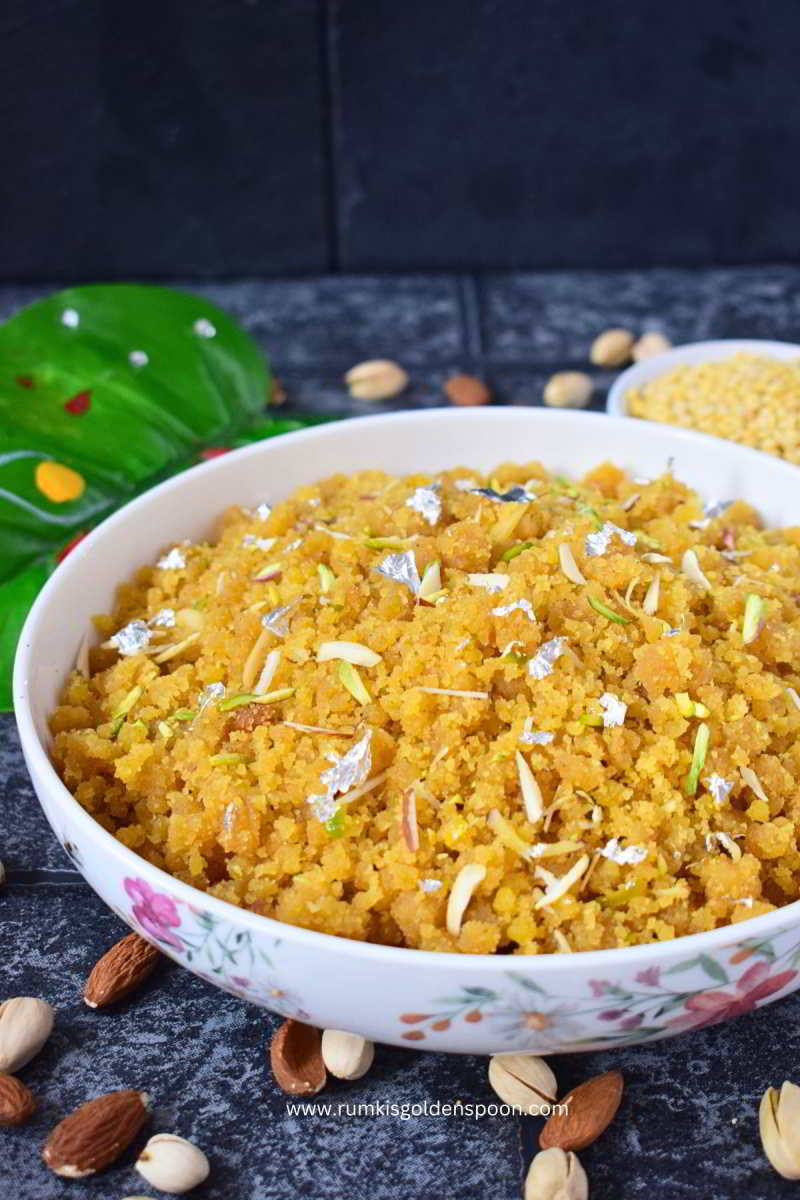Rajasthani moong dal halwa recipe aka mung daal ka halwa recipe is an authentic Indian sweet recipe which is being prepared for ages in Rajasthan and northern India during festive seasons, especially on Diwali. It is a rich, flavoured, and utterly delicious halwa recipe which melts in the mouth. Moong dal ka halwa is basically an Indian lentil pudding where yellow lentils aka moong dal paste is slow cooked in ghee aka clarified butter, milk, sugar, chopped nuts, a generous pinch of saffron and cardamom powder. This splendid delight is mostly relished as dessert after lunch or dinner or as evening snacks. It is mostly served warm to enjoy its best taste.
Indian sweet recipes play a vital role in Indian culinary as well as Indian culture. In any part of India, festivals or ceremonies are incomplete without sweets. In fact, someone’s success or any good news is celebrated by sharing sweets with their close ones. Any celebration with homemade sweet recipes makes every occasion more special and worthier. When it comes to homemade sweets, halwa recipes strike first in any homemaker’s mind. Though moong dal ka halwa is not often prepared in households because of the lengthy process but it is prepared during festive seasons at least once a year. Suji ka halwa, Aate ka halwa, Gajar ka halwa are more often halwa recipes prepared in Indian households.
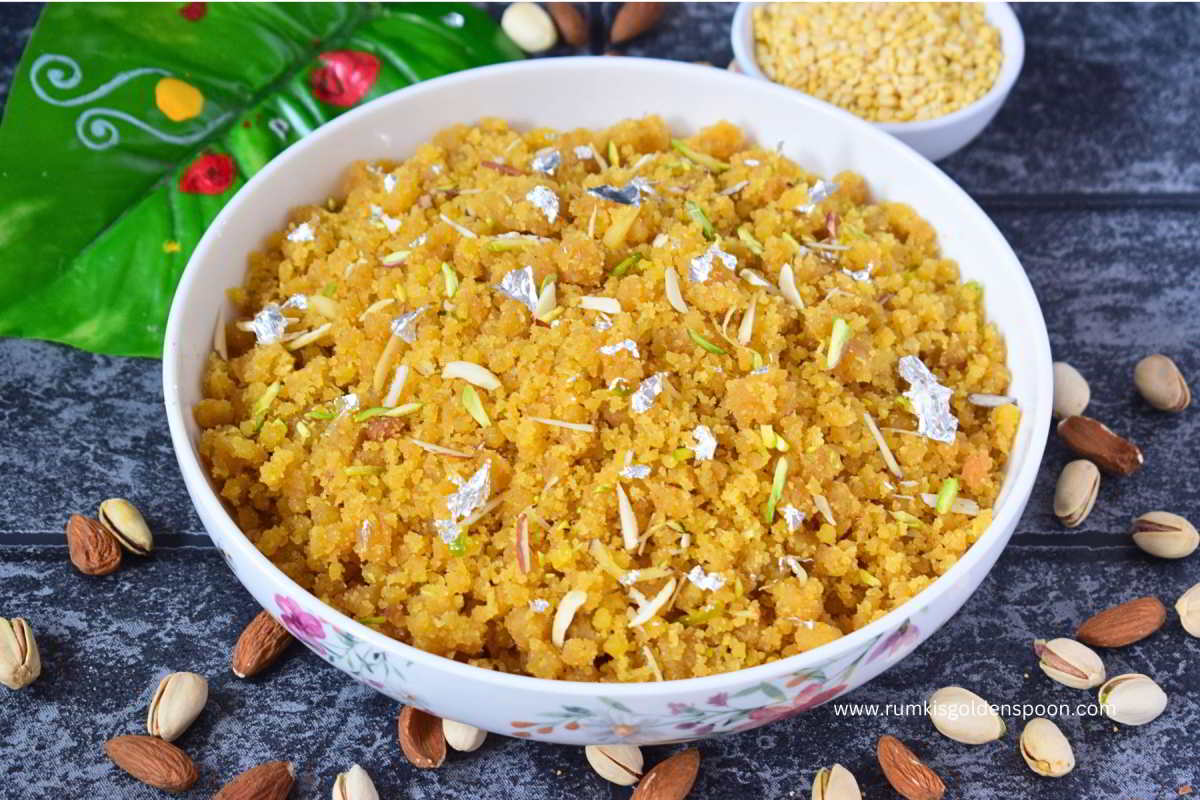
Table of Contents
About the recipe
Tips and Suggestions
Frequently Asked Questions
How to make Moong dal ka Halwa (step wise photos)
Recipe Card
What is Moong dal Halwa?
Moong dal halwa is a classic Rajasthani dessert and the name itself explains the dish. Here, Moong dal stands for split & husked yellow lentils and halwa means sweet pudding. In India, different types of halwa are prepared with different primary elements like semolina, lentils, nuts, seasonal fruits etc. But moong dal ka halwa is undoubtedly one of the most popular and beloved versions of halwa. This candid dessert is known by different names in different parts of India. It is also popular as moong dal sheera in northern India.
Moong dal halwa is a winter delicacy which is basically prepared during the winter season to make you feel warm. People believe that the ghee-roasted lentil halwa helps to keep their bodies warm. Moong dal ka halwa recipe is high in calories and so it helps you to feel full for a long duration. This halwa can be stored for a longer duration in the refrigerator. So, usually, people prepare it in large quantities.
In this preparation, moong dal aka husked and split yellow lentils are soaked in water overnight and then grind till smooth paste. Then the lentil paste is ghee roasted and stirred continuously till you get the texture like bread crumble and then milk, sugar, powdered milk, chopped nuts and flavouring agents are added and cooked. The addition of dry fruits and flavouring agents is completely optional. Essentially, mung dal halwa requires four key ingredients to get prepared – moong dal, milk, ghee and sugar.
Honestly, I always try to avoid preparing this fabulous dessert because it’s really a laborious job to prepare it. To cook the halwa you have to stir the lentil paste continuously or else it will stick to the bottom of the pan. Your arms will do great exercise during the time of preparing this halwa. I always suggest everyone prepare the halwa in a nonstick pan to make the job slightly easier.
How to eat Moong dal ka Halwa?
Rajasthani moong dal halwa recipe is one of the most popular sweets of India and it is eaten in different ways. It tastes best when it is served warm. But it can also be served cold or at room temperature.
Moong dal halwa is mostly served as dessert after lunch or dinner. It can also be served as an evening snack with other snack items.
Nowadays moong dal halwa with vanilla ice cream is one of the most popular fusion dessert recipes which are served by caterers in functions like wedding ceremonies, reception parties etc. Moong dal ka halwa with rabri is another splendid combination which is served in many ceremonies.
Reasons behind the popularity of Moong dal ka Halwa
Moong dal ka halwa recipe is undoubtedly one of the quintessential Indian dessert recipes which are crazily popular all over India and a few other subcontinents of South Asia. The reasons behind its unparallel popularity are
- Its irresistible taste, texture and flavour
- Its richness makes it a perfect dessert for festivals and the winter season.
- Perfect to be served as evening snacks and dessert after meals.
- It can be prepared with only 4 basic ingredients.
- It has a long shelf life and can be stored in the fridge for long.
- It can be frozen for months in the freezer.
- It is vegetarian
- Gluten-free
Whenever I talk about this rich, flavorful and eye catchy halwa recipe, it always makes me feel nostalgic. I have grown up eating this indulging dessert and it’s undoubtedly one of my favorites. I have thousands of good memories attached to this sweet dish.
Honestly, my mom never used to prepare this halwa at home. She always used to prepare suji ka halwa, aate ka halwa and carrot halwa throughout the year but not mung dal ka halwa. But there is a halwai shop in our town where they used to prepare moong dal ka halwa for Diwali and Holi and my dad always used to buy it every year. Everyone in our family loves the dessert because of its extraordinary taste.
Honestly, moong dal halwa recipe is not a simple and easy recipe. Your arms have to do a lot of hard work to make the lentil paste cook evenly. It gets prepared with only four basic ingredients. Additional ingredients are completely optional. All the ingredients are easily available in any Indian kitchen pantry. The best part of the recipe is that you can store it for 7-8 days. So, moong dal halwa recipe is always a great option for the Diwali season. You can prepare it in advance to avoid the last-minute rush.
Moong dal ka halwa recipe with step-by-step photos and instructions have been provided in the ‘Instructions’ section of the recipe. I have included my tip and tricks below in detail to make the recipe easier for you on your very first attempt. But before directly jumping into the recipe, let me share a few interesting facts about the recipe.
Moong dal ka halwa ingredients
The traditional moong dal ka halwa is prepared with milk. No processed ingredients are used like condensed milk, evaporated milk, powdered milk and even mawa aka khoya. The lists of ingredients used for the traditional recipe are
Moong dal: The primary ingredient for the recipe which provides body to it. I washed the dal and soaked it overnight before grinding.
Milk: One of the most important ingredients of the recipe which provides richness, creaminess, flavour and texture to the recipe for moong dal ka halwa.
Ghee aka clarified butter: Another important ingredient for the recipe. It provides a soothing flavour and taste to the moong dal halwa and increases the shelf life.
Sugar: It adds sweetness to the halwa.
Chopped nuts: Chopped nuts are used in the moong dal halwa to provide flavour and bite. You can use a choice of your nuts like cashew, pistachio, almond or walnut for the recipe.
Cardamom powder: It is used as a flavouring agent for the halwa. In most of the Indian sweets, elaichi aka cardamom powder is used to enhance the flavour of the desserts.
Saffron: The addition of saffron enhances the colour and flavour of the dessert recipe.
Tips to prepare perfect Moong dal ka Halwa
- Always soak the dal overnight for grinding.
- Grind the moong dal almost smooth and a little grainy for perfect texture. Don’t use extra water to grind the dal.
- Always use full cream milk to prepare the moong dal halwa. When the milk evaporates, it requires fat to get the perfect texture and taste.
- Moong dal ka halwa is a slow-cooking recipe which requires patience to get cooked. Cook it on low to medium-low flame.
- Stir the content continuously during the time of preparing halwa or else it will stick to the sides and bottom.
- Add chopped nuts of your own choice to enhance the taste and flavour of the dish.
- Don’t skip cardamom powder and saffron from the recipe. It complements the flavour of the dish.
Frequently asked Questions
Can I use butter instead of ghee for the moong dal halwa?
Yes, you can. In fact, you can use any flavourless oil too instead of ghee. But I must say butter will definitely not provide the richness and flavour to the moong dal halwa which you will get from ghee aka clarified butter.
Can I use jaggery instead of sugar for the moong dal halwa?
Yes, you can use jaggery if you are trying to avoid sugar. The moong dal halwa prepared with jaggery gives a little bit of a darker shade as compared to the halwa prepared with sugar.
Can I make vegan moong dal halwa?
Yes, you can. Instead of full cream milk, you can use cashew milk or almond milk. Soak 12-15 cashew nuts or almonds overnight. Next day, peel the skin off the almonds and grind it with half a cup of water to prepare the almond milk or cashew milk. Instead of ghee, you can use any edible oil. Though the vegan moong dal halwa will taste good but you have to compromise on a few factors. The taste, flavour and texture of vegan moong dal halwa won’t be the same as the traditional moong dal halwa recipe.
How to store moong dal halwa?
Moong dal ka halwa has got a long shelf life. After preparing the halwa, allow it to come to room temperature. Then transfer them to a clean and dry airtight glass container. You can refrigerate it for 7-8 days. Just take the moong dal halwa out and warm it before serving.
Can I freeze moong dal halwa?
Yes, of course. But before that, make sure to store the moong dal halwa in a freezer-safe container. You can freeze the halwa and keep it in the freezer for 1 to 1.5 months.
How to heat mung dal ka halwa?
On a stovetop, you can directly heat the moong dal halwa recipe over low to medium-low flame. But I always prefer the double boiler method to heat the halwa. In this way, the halwa gets warm evenly without losing its taste.
You can also use the microwave to heat the moong dal ka halwa recipe. Heat it and stir thoroughly every 30 seconds intervals.
How to make Moong dal ka Halwa?
To prepare moong dal halwa, first, wash the moong dal aka yellow lentils 2-3 times and then soak it for at least 5 hours or overnight. It is very important to soak the dal properly for perfect moong dal ka halwa. Next day, drain the excess water from the dal and wash it one more time.
Transfer the moong dal into a jar of a grinder and close the lid. Grind it to a slightly grainy paste.
Now put a pan on flame and allow it to become completely dry. Add ghee into the pan and let it melt. Add the moong dal paste into the pan and give a nice mix. Cook it over medium-low to medium flame and stir it continuously until you get the texture like bread crumbs. Initially, the lentil paste absorbs all the ghee and slowly will turn into lumps which you need to break with the spatula and mix it. Slowly the content will reduce the moisture and at last turn into crispy crumbs till then stir it. The whole process takes around 20-25 minutes.
This is the most crucial part of the recipe where you need to be patient and stir the content continuously. There is no other shortcut for this part. You must cook it over a low or medium-low flame or else the lentil paste won’t get cooked properly and the raw taste of the lentil will spoil the halwa.
Then add milk into the pan and mix it well. Add a pinch of saffron to get a nice flavour and colour and mix it. Cook it over low flame so the moong dal crumbles can absorb the milk completely.
When the content starts to hold shape add milk powder and mix it evenly. The addition of milk powder is completely optional. But it adds extra richness and enhances the taste of the halwa.
Now add sugar to the pan and mix it well. Initially, the sugar will melt and the mixture will turn gooey. Stir the content continuously and cook it over low flame. The content will turn into mass, break the lumps with a spatula and stir. Then the mixture slowly releases the side and changes the colour to light brownish. This process takes almost 30 minutes to get the texture.
Add cardamom powder and mix it well. At the final stage add the chopped almond, cashew, pistachios and mix them well. Turn off the flame and the moong dal halwa is ready to serve now.
Many halwa recipes have already been shared in my previous posts. You can check a few of them like
Gajar halwa
Sooji ka halwa
Mango halwa
Apple ka halwa
..And Many more…
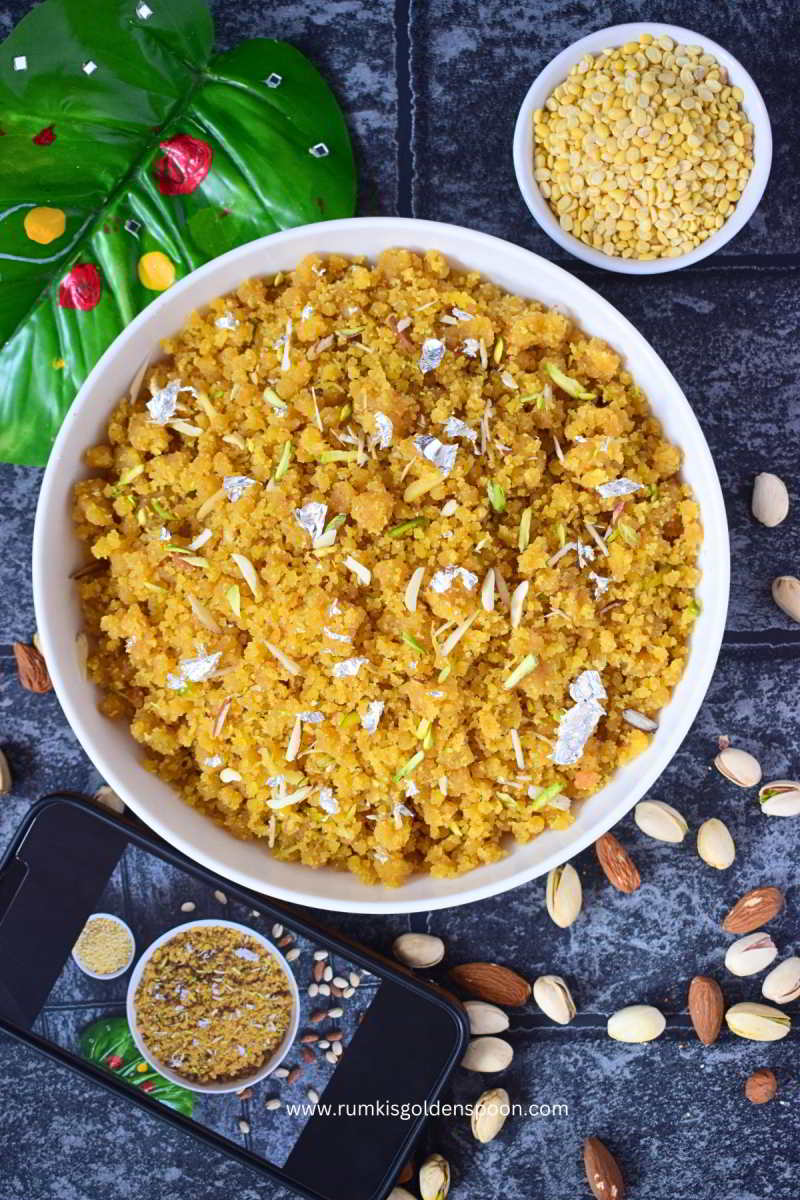
Ingredients:
1 cup = 250 ml
- 1 cup Moong dal aka split and husked yellow Lentils
- 2¼ cup full cream Milk
- ½ cup & 1 tablespoon Ghee aka clarified butter
- 1 cup Sugar (adjust accordingly)
- ¼ cup Milk powder
- 10-12 streaks of Saffron aka Kesar
- ½ teaspoon Cardamom powder (Elaichi powder)
- 1 tablespoon Cashew, chopped
- 1 tablespoon Pistachio, chopped
- 1 tablespoon Almond, chopped
Instructions:
- First, wash 1 cup moong dal aka yellow lentils 2-3 times and then soak it for at least 5 hours or overnight. It is very important to soak the dal properly for perfect moong dal ka halwa. Next day, drain the excess water from the dal and wash it one more time.
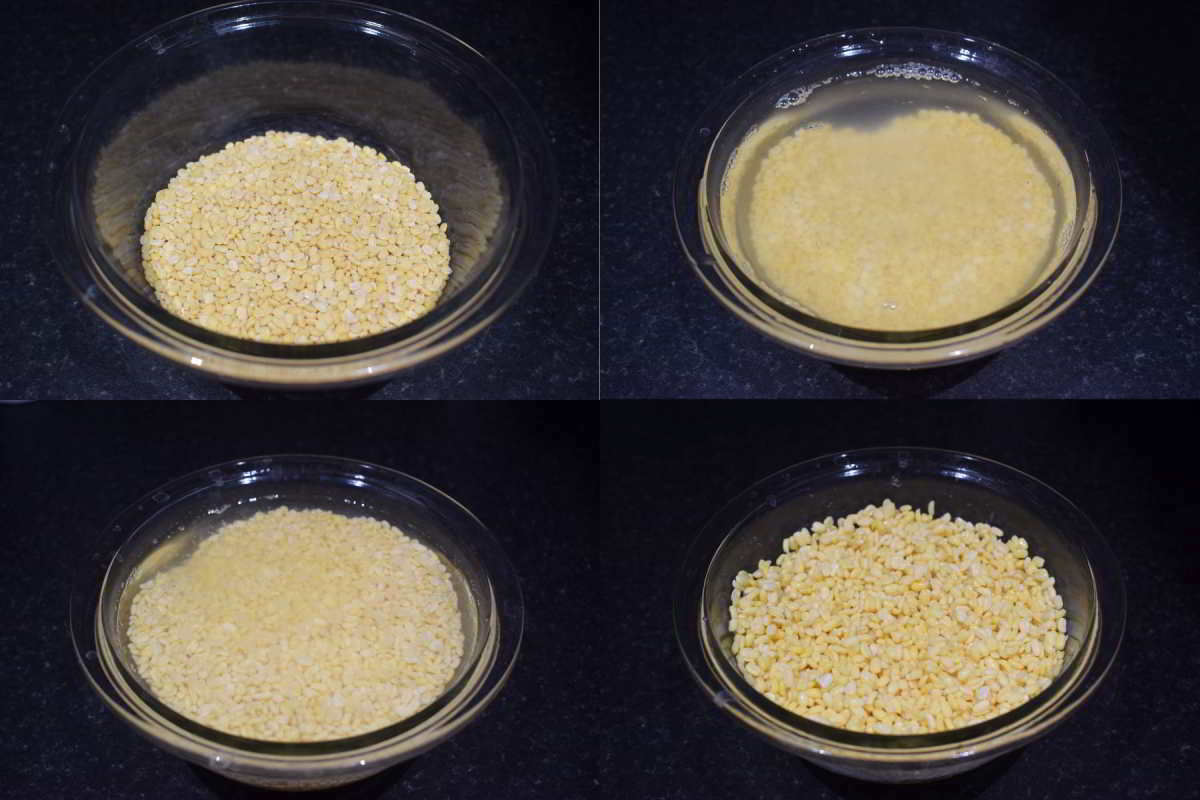
- Transfer the moong dal into a jar of a grinder and close the lid. Grind it to a slightly grainy paste. Try not to use extra water or a minimal amount of water to grind the lentil paste.
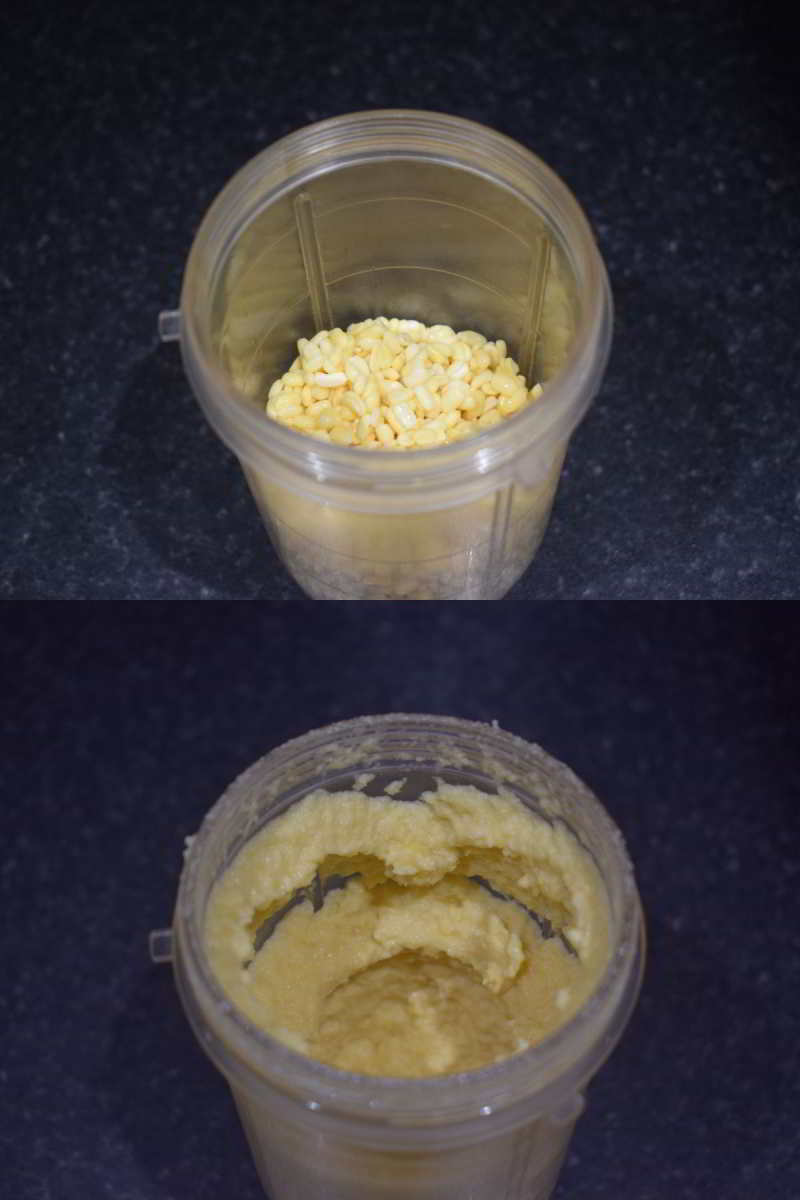
- Transfer the whole content into a bowl.
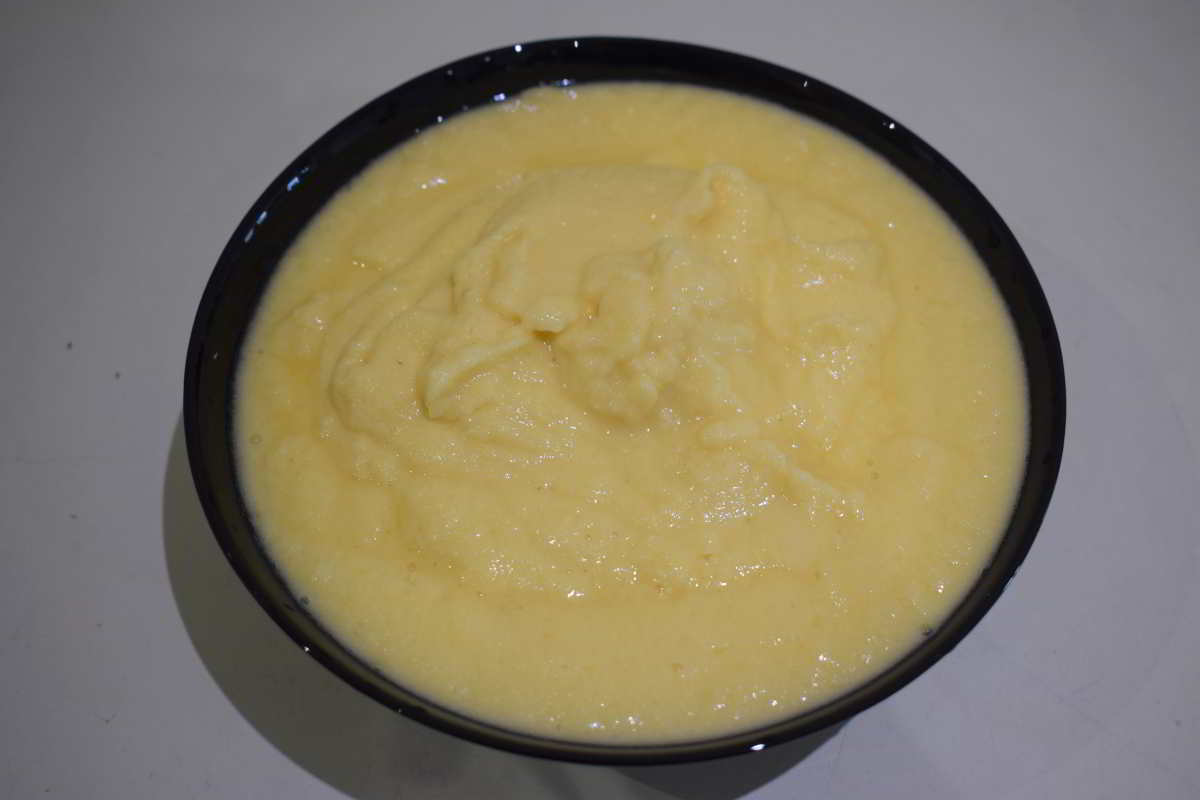
- Now put a pan on flame and allow it to become completely dry. Add ½ cup and 1 tablespoon ghee into the pan and let it melt.
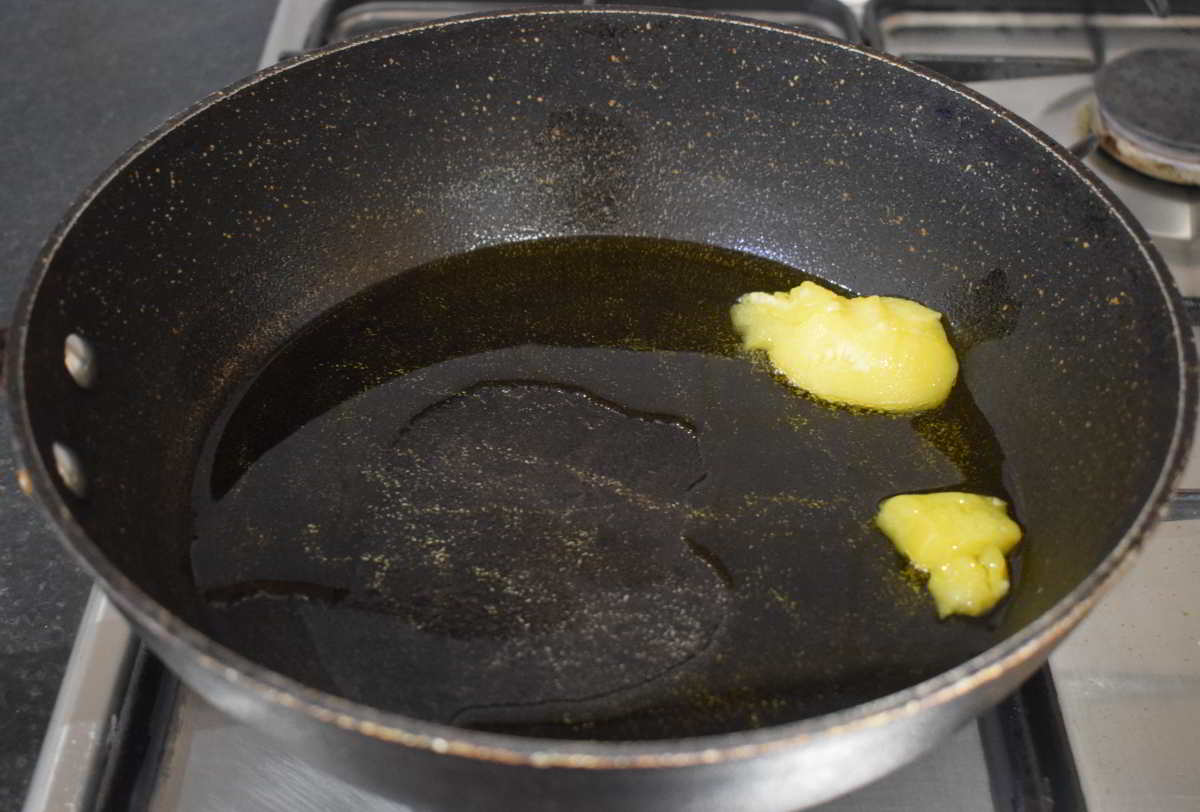
- Add the moong dal paste (Step 2) into the pan and give a nice mix. Cook it over medium-low to medium flame and stir it continuously until you get the texture like bread crumbs. Initially, the lentil paste absorbs all the ghee and slowly will turn into lumps which you need to break with the spatula and mix it. Slowly the content will reduce the moisture and at last turn into crispy crumbs till then stir it. The whole process takes around 20-25 minutes.
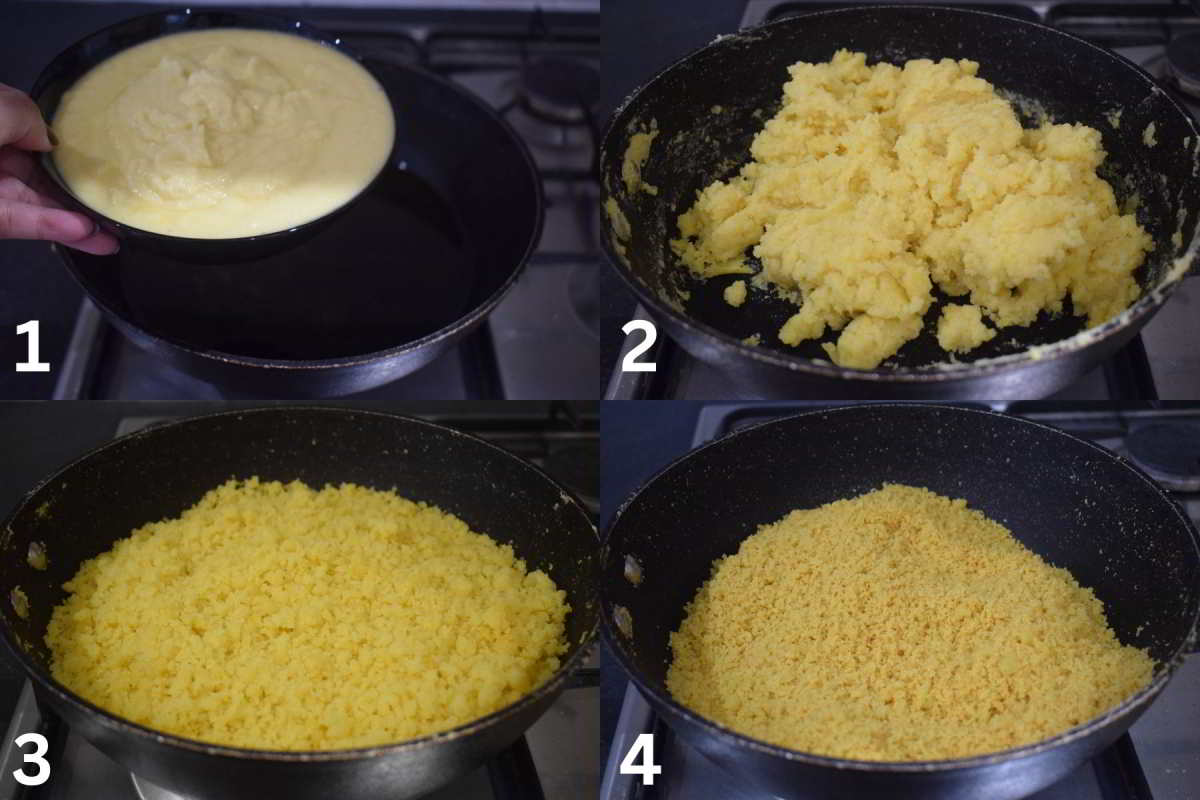 Note: This is the most crucial part of the recipe where you need to be patient and stir the content continuously. There is no other shortcut for this part. You must cook it over low or medium low flame or else the lentil paste won’t get cook properly and raw taste of the lentil will spoil the halwa.
Note: This is the most crucial part of the recipe where you need to be patient and stir the content continuously. There is no other shortcut for this part. You must cook it over low or medium low flame or else the lentil paste won’t get cook properly and raw taste of the lentil will spoil the halwa. - Add 2¼ cups milk into the pan and mix it well.
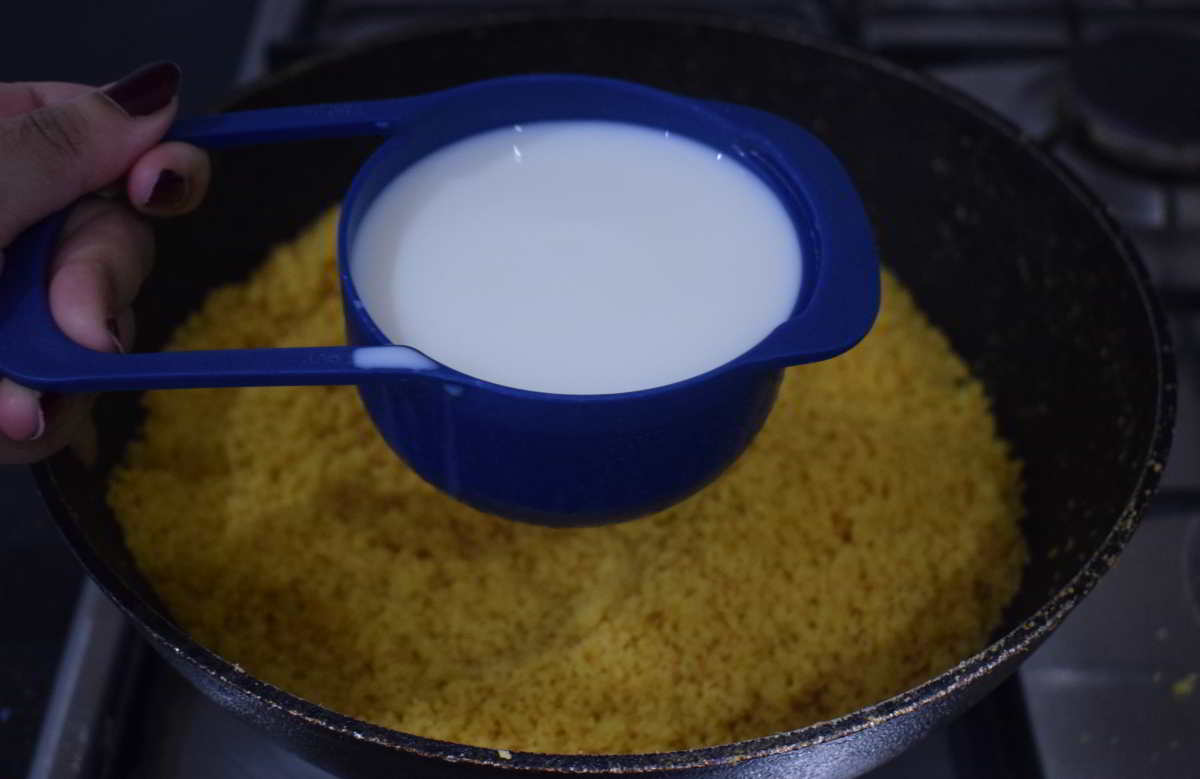
- Add a pinch of saffron to get a nice flavour and colour and mix it. Cook it over low flame so the moong dal crumbles can absorb the milk completely.
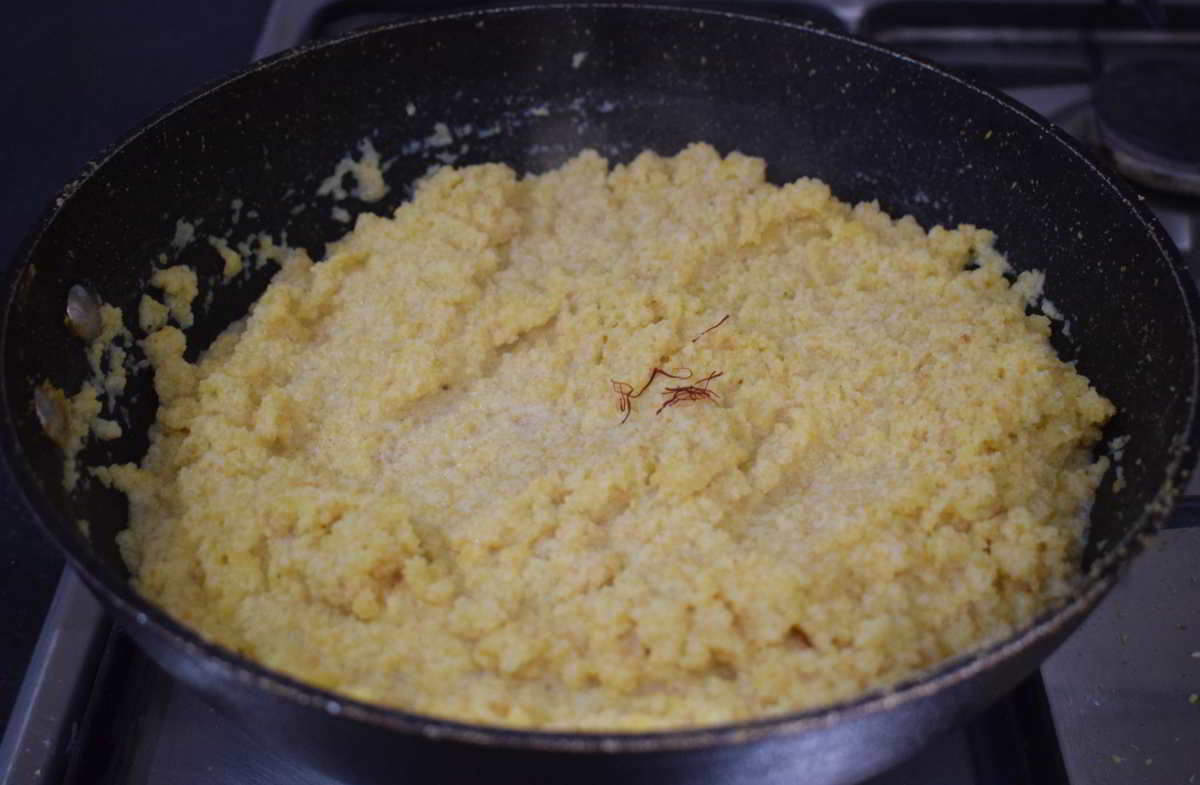
- When the content starts to hold shape add ¼ cup milk powder and mix it evenly. The addition of milk powder is completely optional. But it adds extra richness and enhances the taste of the halwa.
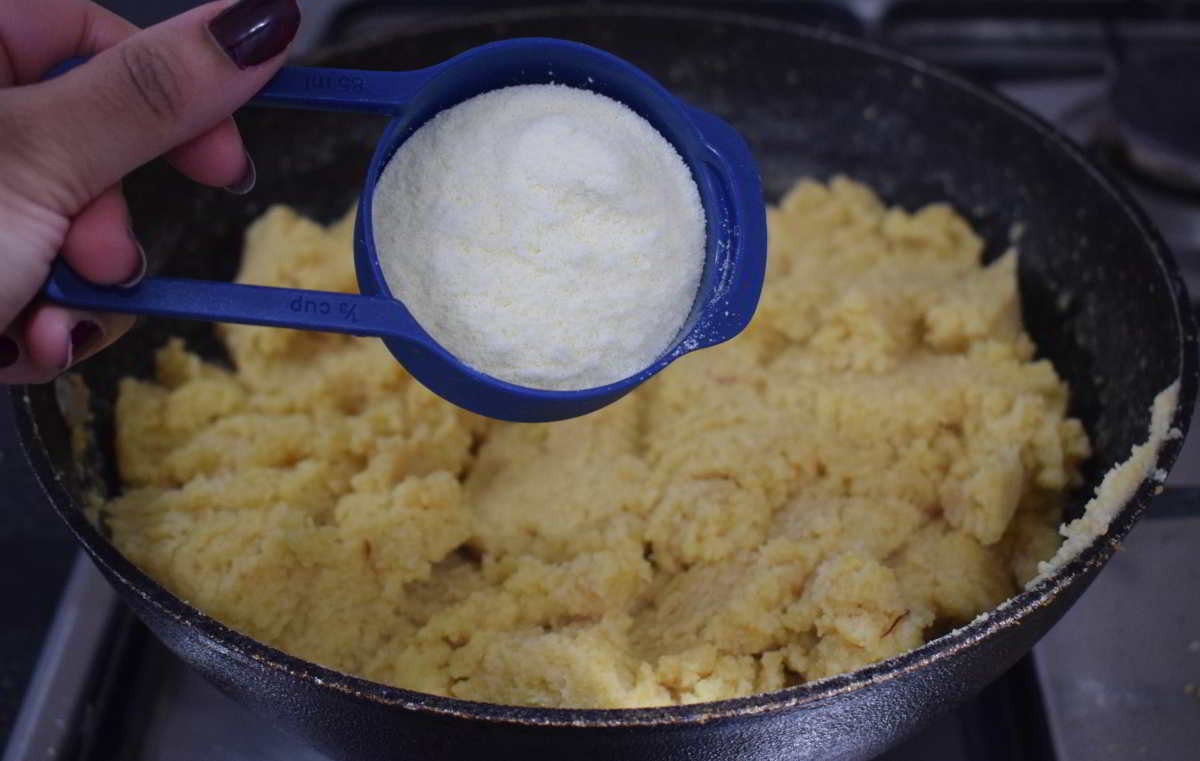
- Now add 1 cup sugar into the pan and mix it well. Initially, the sugar will melt and the mixture will turn gooey. Stir the content continuously and cook it over low flame. The content will turn into mass, break the lumps with a spatula and stir. Then the mixture slowly releases the side and changes the colour to light brownish. This process takes almost 30 minutes to get the texture.
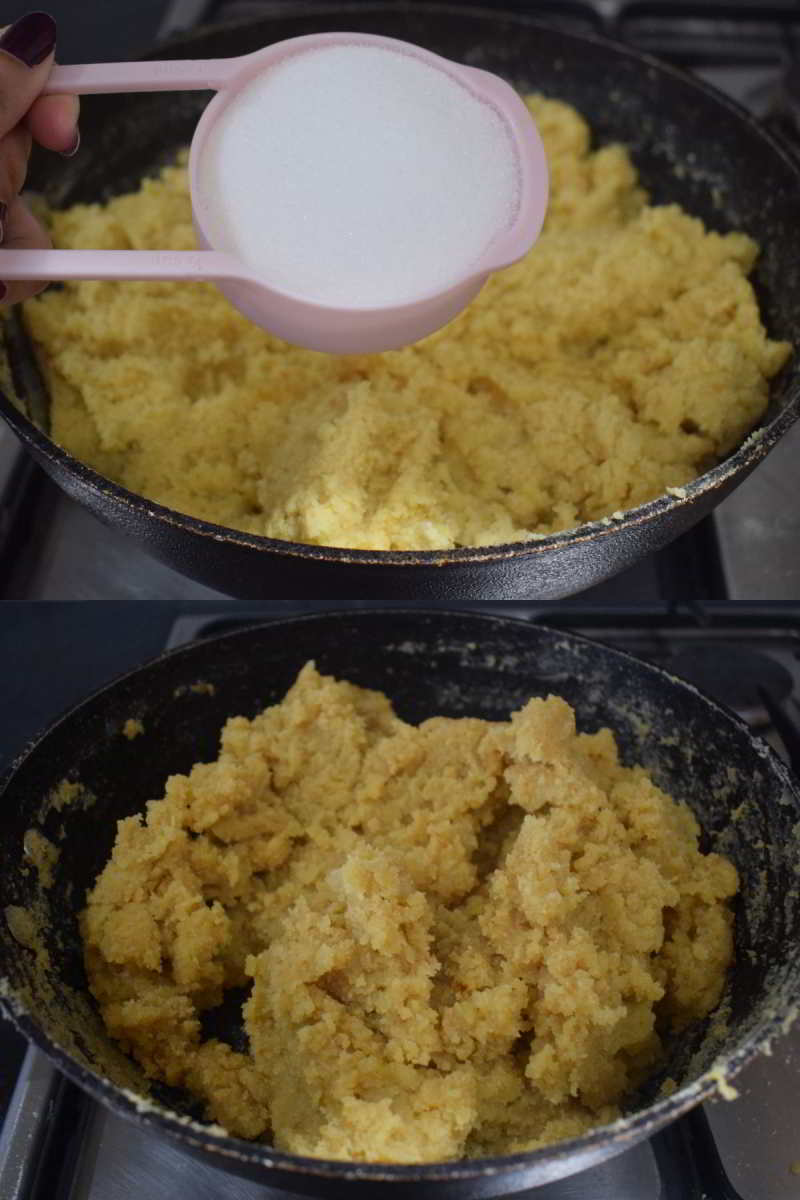
- Add ½ teaspoon cardamom powder and mix it well.
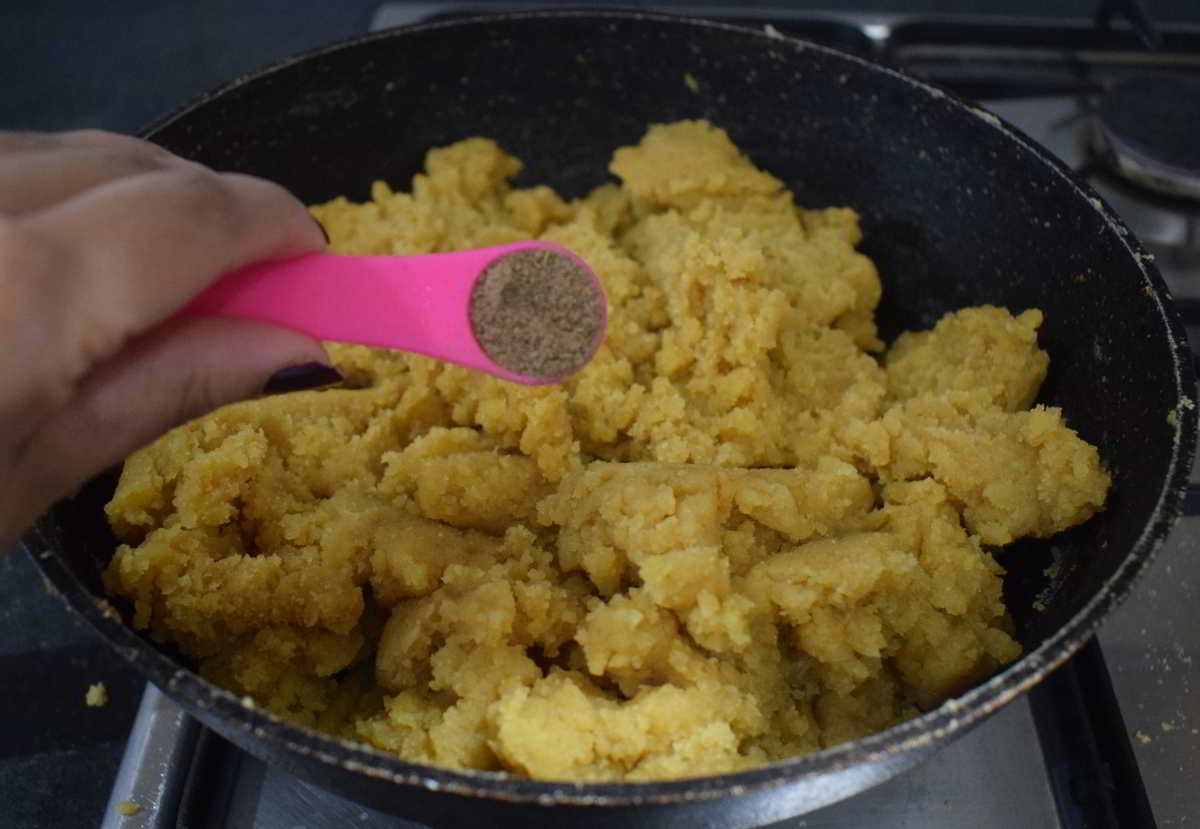
- At the final stage, add the 1 tablespoon chopped almond, 1 tablespoon chopped cashew, 1 tablespoon chopped pistachios and mix it well.
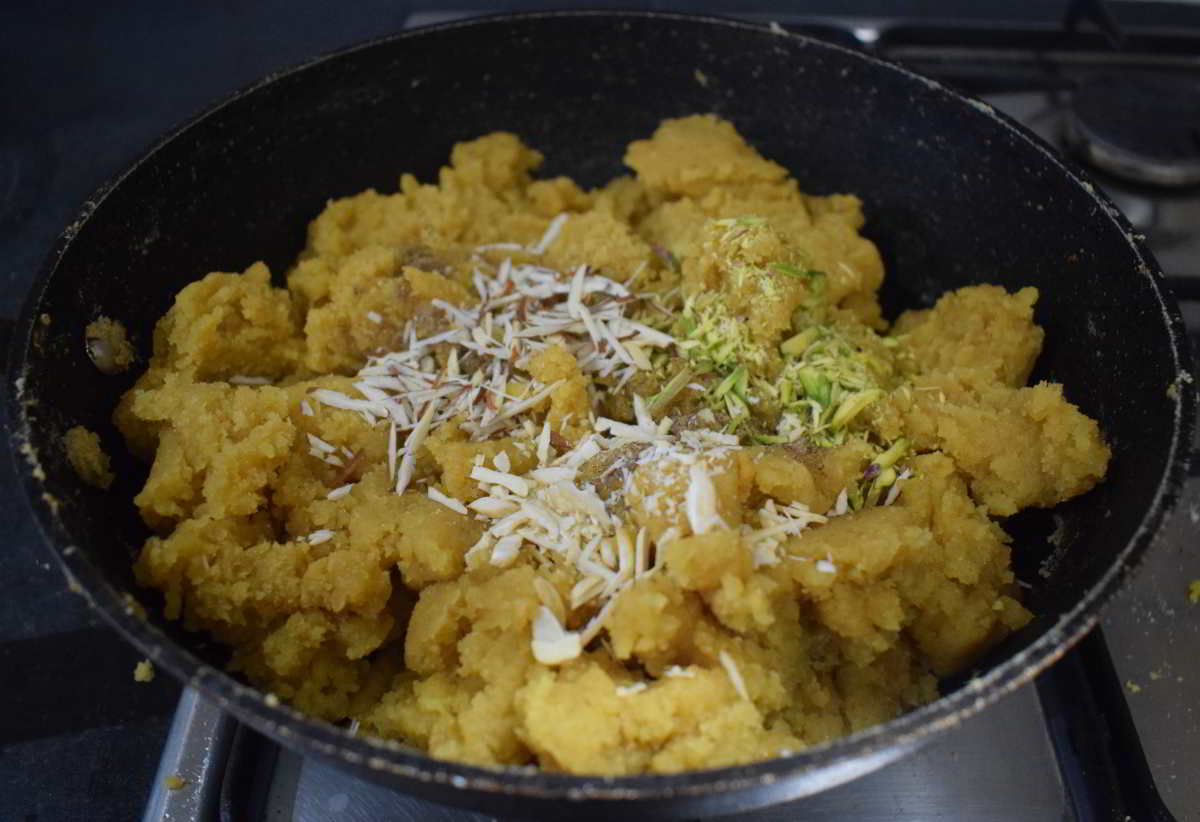
- Turn off the flame and the moong dal halwa is ready to serve now.
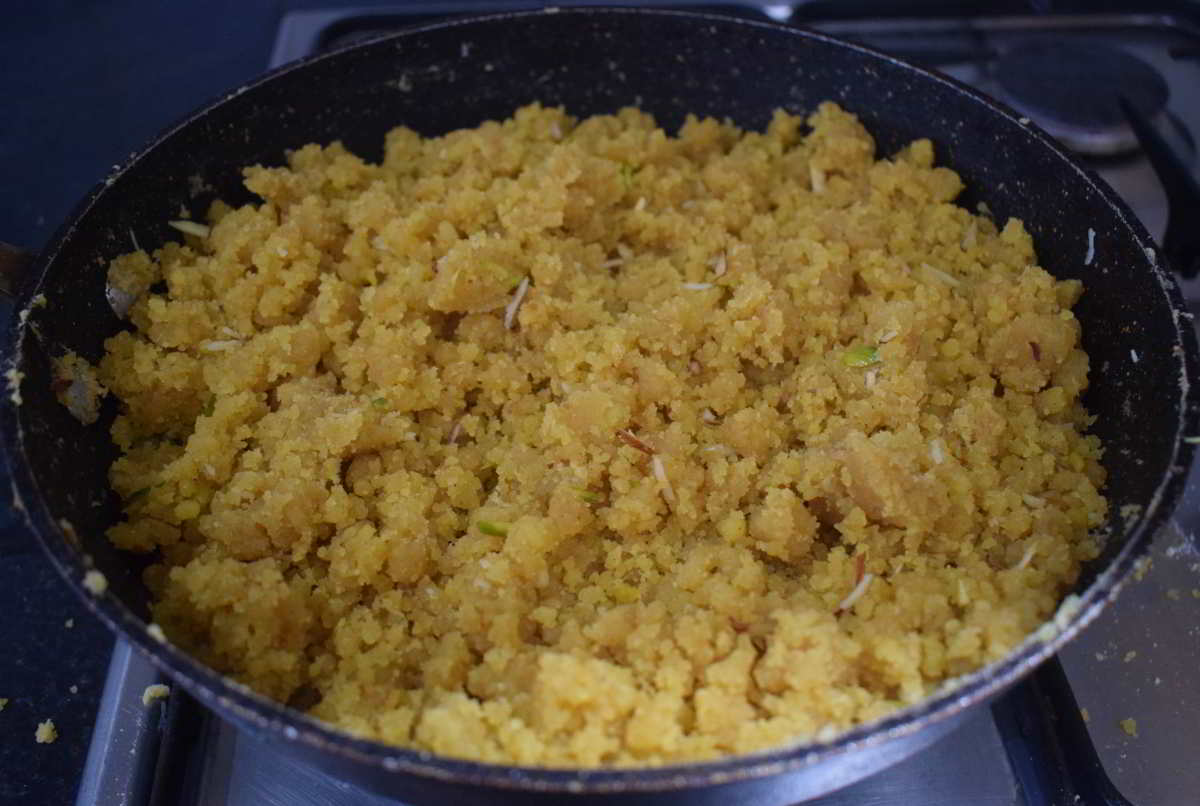
Serving Instruction
Serve the Rajasthani moong dal halwa recipe on a serving plate or in a serving bowl. Serve it warm to enjoy its best taste and garnish it with some chopped nuts. Serve the moong dal halwa recipe as dessert after a meal or as an evening snack and enjoy the Indian delicacy.
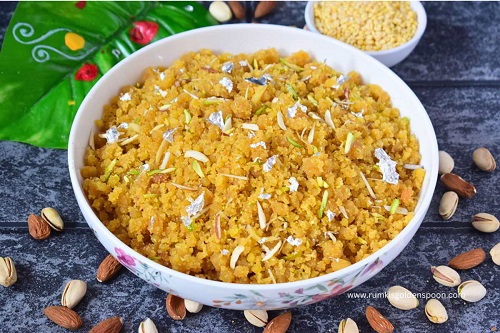
Ingredients
1 cup = 250 ml
- 1 cup Moong dal aka split and husked yellow Lentils
- 2¼ cup full cream Milk
- ½ cup & 1 tablespoon Ghee aka clarified butter
- 1 cup Sugar (adjust accordingly)
- ¼ cup Milk powder
- 10-12 streaks of Saffron aka Kesar
- ½ teaspoon Cardamom powder (Elaichi powder)
- 1 tablespoon Cashew, chopped
- 1 tablespoon Pistachio, chopped
- 1 tablespoon Almond, chopped
Instructions
- First, wash 1 cup moong dal aka yellow lentils 2-3 times and then soak it for at least 5 hours or overnight. It is very important to soak the dal properly for perfect moong dal ka halwa. Next day, drain the excess water from the dal and wash it one more time.
- Transfer the moong dal into a jar of a grinder and close the lid. Grind it to a slightly grainy paste. Try not to use extra water or a minimal amount of water to grind the lentil paste.
- Transfer the whole content into a bowl.
- Now put a pan on flame and allow it to become completely dry. Add ½ cup and 1 tablespoon ghee into the pan and let it melt.
- Add the moong dal paste (Step 2) into the pan and give a nice mix. Cook it over medium-low to medium flame and stir it continuously until you get the texture like bread crumbs. Initially, the lentil paste absorbs all the ghee and slowly will turn into lumps which you need to break with the spatula and mix it. Slowly the content will reduce the moisture and at last turn into crispy crumbs till then stir it. The whole process takes around 20-25 minutes. Note: This is the most crucial part of the recipe where you need to be patient and stir the content continuously. There is no other shortcut for this part. You must cook it over low or medium low flame or else the lentil paste won’t get cook properly and raw taste of the lentil will spoil the halwa.
- Add 2¼ cups milk into the pan and mix it well.
- Add a pinch of saffron to get a nice flavour and colour and mix it. Cook it over low flame so the moong dal crumbles can absorb the milk completely.
- When the content starts to hold shape add ¼ cup milk powder and mix it evenly. The addition of milk powder is completely optional. But it adds extra richness and enhances the taste of the halwa.
- Now add 1 cup sugar into the pan and mix it well. Initially, the sugar will melt and the mixture will turn gooey. Stir the content continuously and cook it over low flame. The content will turn into mass, break the lumps with a spatula and stir. Then the mixture slowly releases the side and changes the colour to light brownish. This process takes almost 30 minutes to get the texture.
- Add ½ teaspoon cardamom powder and mix it well.
- At the final stage, add the 1 tablespoon chopped almond, 1 tablespoon chopped cashew, 1 tablespoon chopped pistachios and mix it well.
- Turn off the flame and the moong dal halwa is ready to serve now.

